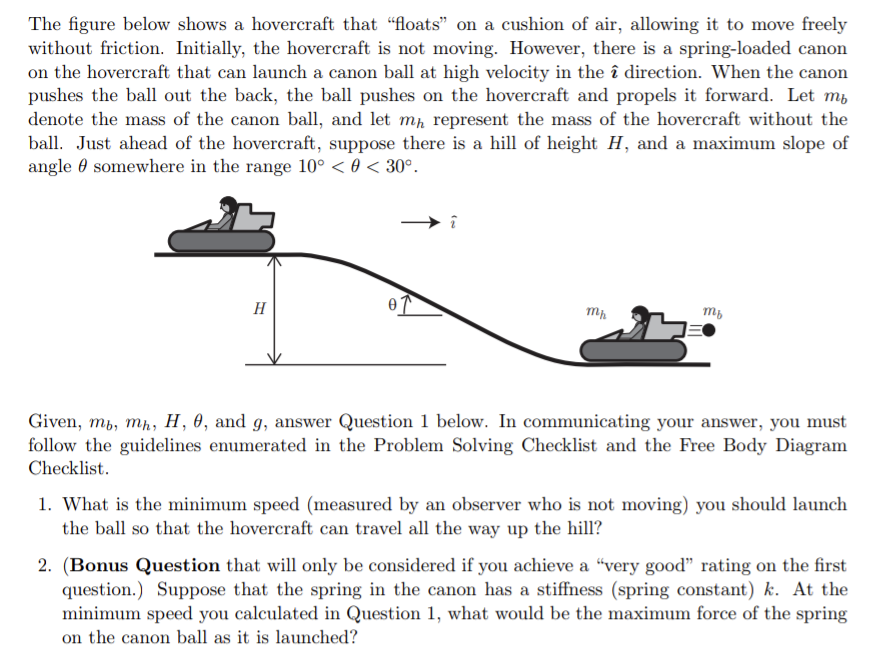The figure below shows a hovercraft that "floats" on a cushion of air, allowing it to move freely without friction. Initially, the hovercraft is not moving. However, there is a spring-loaded canon on the hovercraft that can launch a canon ball at high velocity in the î direction. When the canon pushes the ball out the back, the ball pushes on the hovercraft and propels it forward. Let m, denote the mass of the canon ball, and let m, represent the mass of the hovercraft without the ball. Just ahead of the hovercraft, suppose there is a hill of height H, and a maximum slope of angle 0 somewhere in the range 10° < 0 < 30°. H Given, mb, mh, H, 0, and g, answer Question 1 below. In communicating your answer, you must follow the guidelines enumerated in the Problem Solving Checklist and the Free Body Diagram Checklist. 1. What is the minimum speed (measured by an observer who is not moving) you should launch the ball so that the hovercraft can travel all the way up the hill?
The figure below shows a hovercraft that "floats" on a cushion of air, allowing it to move freely without friction. Initially, the hovercraft is not moving. However, there is a spring-loaded canon on the hovercraft that can launch a canon ball at high velocity in the î direction. When the canon pushes the ball out the back, the ball pushes on the hovercraft and propels it forward. Let m, denote the mass of the canon ball, and let m, represent the mass of the hovercraft without the ball. Just ahead of the hovercraft, suppose there is a hill of height H, and a maximum slope of angle 0 somewhere in the range 10° < 0 < 30°. H Given, mb, mh, H, 0, and g, answer Question 1 below. In communicating your answer, you must follow the guidelines enumerated in the Problem Solving Checklist and the Free Body Diagram Checklist. 1. What is the minimum speed (measured by an observer who is not moving) you should launch the ball so that the hovercraft can travel all the way up the hill?
Elements Of Electromagnetics
7th Edition
ISBN:9780190698614
Author:Sadiku, Matthew N. O.
Publisher:Sadiku, Matthew N. O.
ChapterMA: Math Assessment
Section: Chapter Questions
Problem 1.1MA
Related questions
Question
I need the answers to the questions and need a good force body diagram and mass acceleration diagram

Transcribed Image Text:The figure below shows a hovercraft that "floats" on a cushion of air, allowing it to move freely
without friction. Initially, the hovercraft is not moving. However, there is a spring-loaded canon
on the hovercraft that can launch a canon ball at high velocity in the î direction. When the canon
pushes the ball out the back, the ball pushes on the hovercraft and propels it forward. Let m,
denote the mass of the canon ball, and let mp represent the mass of the hovercraft without the
ball. Just ahead of the hovercraft, suppose there is a hill of height H, and a maximum slope of
angle 0 somewhere in the range 10° < 0 < 30°.
H
Given, mb, mh, H, 0, and g, answer Question 1 below. In communicating your answer, you must
follow the guidelines enumerated in the Problem Solving Checklist and the Free Body Diagram
Checklist.
1. What is the minimum speed (measured by an observer who is not moving) you should launch
the ball so that the hovercraft can travel all the way up the hill?
2. (Bonus Question that will only be considered if you achieve a "very good" rating on the first
question.) Suppose that the spring in the canon has a stiffness (spring constant) k. At the
minimum speed you calculated in Question 1, what would be the maximum force of the spring
on the canon ball as it is launched?
Expert Solution
This question has been solved!
Explore an expertly crafted, step-by-step solution for a thorough understanding of key concepts.
This is a popular solution!
Trending now
This is a popular solution!
Step by step
Solved in 3 steps with 2 images

Follow-up Questions
Read through expert solutions to related follow-up questions below.
Follow-up Question
For answer number 2 can you write that with the radical shown?
Solution
Follow-up Question
can this be type i dont see how this can be put as an equation
Solution
Follow-up Question
Is there anyway you can write the equations doesn't make sense with equations typed like that
Solution
Knowledge Booster
Learn more about
Need a deep-dive on the concept behind this application? Look no further. Learn more about this topic, mechanical-engineering and related others by exploring similar questions and additional content below.Recommended textbooks for you

Elements Of Electromagnetics
Mechanical Engineering
ISBN:
9780190698614
Author:
Sadiku, Matthew N. O.
Publisher:
Oxford University Press

Mechanics of Materials (10th Edition)
Mechanical Engineering
ISBN:
9780134319650
Author:
Russell C. Hibbeler
Publisher:
PEARSON

Thermodynamics: An Engineering Approach
Mechanical Engineering
ISBN:
9781259822674
Author:
Yunus A. Cengel Dr., Michael A. Boles
Publisher:
McGraw-Hill Education

Elements Of Electromagnetics
Mechanical Engineering
ISBN:
9780190698614
Author:
Sadiku, Matthew N. O.
Publisher:
Oxford University Press

Mechanics of Materials (10th Edition)
Mechanical Engineering
ISBN:
9780134319650
Author:
Russell C. Hibbeler
Publisher:
PEARSON

Thermodynamics: An Engineering Approach
Mechanical Engineering
ISBN:
9781259822674
Author:
Yunus A. Cengel Dr., Michael A. Boles
Publisher:
McGraw-Hill Education

Control Systems Engineering
Mechanical Engineering
ISBN:
9781118170519
Author:
Norman S. Nise
Publisher:
WILEY

Mechanics of Materials (MindTap Course List)
Mechanical Engineering
ISBN:
9781337093347
Author:
Barry J. Goodno, James M. Gere
Publisher:
Cengage Learning

Engineering Mechanics: Statics
Mechanical Engineering
ISBN:
9781118807330
Author:
James L. Meriam, L. G. Kraige, J. N. Bolton
Publisher:
WILEY